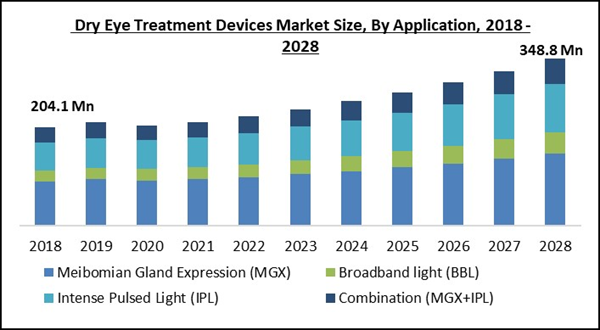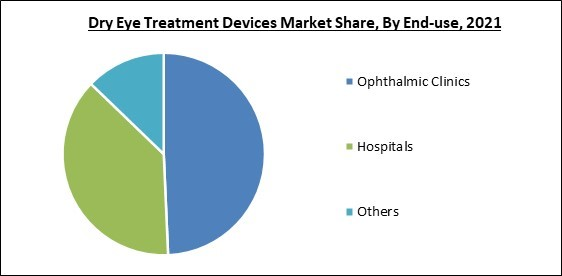The Global Dry Eye Treatment Devices Market size is expected to reach $348.8 million by 2028, rising at a market growth of 7.4% CAGR during the forecast period.
As a result, the treatment must be customized to each patient by focusing on the distinct mechanisms linked to their condition, depending on the various presentations and pathophysiology. Several medical remedies and methods are either on the market or being researched for the management of DED. There is a disruption in tear production, assimilation, and drainage when the eye is unable to generate enough tears of acceptable quality.
Dry eye disease is the term for the medical illness that occurs when the eye develops an adequate volume of tears, but these tears are unable to adequately lubricate the eye, defend against infection, or monitor the eye surface's wound healing (DED). One of the most frequent issues in ophthalmology is dry eye.
Hyperemia, low tear lakes, a quick tear break-up period, and Meibomian gland illness are a few symptoms that can appear. Slit-lamp examinations with and without various stains, such as fluorescein, rose Bengal, and lissamine green, are being used to make diagnoses. The Schirmer test, tear break-up time, tear function index, and functional visual acuity are further tests.
The market research report covers the analysis of key stake holders of the market. Key companies profiled in the report include MiBo Medical Group, Sight Sciences, Inc., Lumenis Ltd., ESW Vision SAS, Johnson & Johnson Vision Care, Inc. and Alcon, Inc.
As a result, the treatment must be customized to each patient by focusing on the distinct mechanisms linked to their condition, depending on the various presentations and pathophysiology. Several medical remedies and methods are either on the market or being researched for the management of DED. There is a disruption in tear production, assimilation, and drainage when the eye is unable to generate enough tears of acceptable quality.
Dry eye disease is the term for the medical illness that occurs when the eye develops an adequate volume of tears, but these tears are unable to adequately lubricate the eye, defend against infection, or monitor the eye surface's wound healing (DED). One of the most frequent issues in ophthalmology is dry eye.
Hyperemia, low tear lakes, a quick tear break-up period, and Meibomian gland illness are a few symptoms that can appear. Slit-lamp examinations with and without various stains, such as fluorescein, rose Bengal, and lissamine green, are being used to make diagnoses. The Schirmer test, tear break-up time, tear function index, and functional visual acuity are further tests.
COVID-19 Impact Analysis
The pandemic is anticipated to harm the market growth for dry eye treatment devices. The use of dry eye treatment devices dropped as a result of the cancellation and postponement of elective procedures to minimize the spread of viruses. As the eyes serve as a point of entry for the virus, the deployment of restrictive measures also resulted in the closure of business operations, which decreased the patient number. After the elimination of restrictions and the continuation of treatments, however, an increase in the number of dry eye patients may result in a rise in the demand for treatment devices.Market Growth Factors
An Upsurge in The Number of Eye Care Facilities
Dry eye syndrome (DES) is a chronic illness caused by inadequate tear production and maintenance, which leads to a variety of symptoms that differ from person to person. The number of people with dry eyes has grown recently for a variety of causes, leading to an increase in eye care facilities. The number of specialists working in the field of eye care is steadily rising, and ophthalmologists are anticipated to continue to be in demand. Vision loss is becoming a significant public health issue as the population's demographics continue to change.High Incidence and High Prevalence of Dry Eye Diseases
An extremely prevalent and underdiagnosed ocular condition is dry eye. It is problematic not just because of the symptoms it causes, but also because it costs a lot of money. Patients who have dry eyes experience uncomfortable symptoms of dry eye, including burning, stinging, grittiness, soft tissue sensation, tearing, ocular fatigue, and dryness, because their tear film is unstable and unable to maintain the protective qualities required for its structure and function. The prevalence of dry eye syndrome has increased in recent years; it is a prevalent ailment.Market Restraining Factors
DED Therapy Complications and Pain
The DED is considered as an untreatable condition that needs constant care to restore and keep the ocular surface system's equilibrium. Considering that DED symptoms are usually exacerbated by diseases such as blepharitis, diabetes, thyroid problems, rheumatoid arthritis, systemic lupus, and Sjogren's syndrome. Patient education is an essential initial step in the efficient management of DED. Patients should be made aware by ophthalmologists that DED is a chronic illness that calls for continual care. There is a potential that problems will develop either immediately after the treatment or afterward.Technology Outlook
Based on the Technology, the Dry Eye Treatment Devices Market is segmented into Broadband light (BBL), Intense Pulsed Light (IPL), Meibomian Gland Expression (MGX), and Combination (MGX+IPL). The intense pulsed light (IPL) segment garnered a significant revenue share in the dry eye treatment devices market in 2021. It is projected that market players' proactive efforts to strengthen their distribution networks through alliances and partnerships would contribute to the segment's expansion.End User Outlook
On the basis of End Use, the Dry Eye Treatment Devices Market is divided into Hospitals, Ophthalmic Clinics, and Others. The ophthalmic clinics segment witnessed the highest revenue share in the dry eye treatment devices market in 2021. An ophthalmologist is a physician who focuses on identifying and treating diseases of the eyes. Ophthalmologists who are subspecialists have typically undergone training that enables them to treat complex eye disorders, involve a particular aspect of the eye, or affect particular populations.Regional Outlook
Region-wise, the Dry Eye Treatment Devices Market is analyzed across North America, Europe, Asia Pacific, and LAMEA. North America procured the biggest revenue share in the dry eye treatment devices market in 2021. It is due to the high prevalence of dry eye illness, rising R&D spending, and an increase in the number of ophthalmology trade conferences and expos held in the United States and Canada. Dry eye diseases (DED) are becoming more and more common in the United States, which is increasing the demand for cutting-edge treatments.The market research report covers the analysis of key stake holders of the market. Key companies profiled in the report include MiBo Medical Group, Sight Sciences, Inc., Lumenis Ltd., ESW Vision SAS, Johnson & Johnson Vision Care, Inc. and Alcon, Inc.
Scope of the Study
Market Segments Covered in the Report:
By Technology
- Meibomian Gland Expression (MGX)
- Broadband light (BBL)
- Intense Pulsed Light (IPL)
- Combination (MGX+IPL)
By End User
- Ophthalmic Clinics
- Hospitals
- Others
By Geography
- North America
- US
- Canada
- Mexico
- Rest of North America
- Europe
- Germany
- UK
- France
- Russia
- Spain
- Italy
- Rest of Europe
- Asia Pacific
- China
- Japan
- India
- South Korea
- Singapore
- Australia
- Rest of Asia Pacific
- LAMEA
- Brazil
- Argentina
- UAE
- Saudi Arabia
- South Africa
- Nigeria
- Rest of LAMEA
Key Market Players
List of Companies Profiled in the Report:
- MiBo Medical Group
- Sight Sciences, Inc.
- Lumenis Ltd.
- ESW Vision SAS
- Johnson & Johnson Vision Care, Inc.
- Alcon, Inc.
Unique Offerings from the Publisher
- Exhaustive coverage
- The highest number of Market tables and figures
- Subscription-based model available
- Guaranteed best price
- Assured post sales research support with 10% customization free
Table of Contents
Chapter 1. Market Scope & Methodology
Chapter 2. Market Overview
Chapter 3. Global Dry Eye Treatment Devices Market by Technology
Chapter 4. Global Dry Eye Treatment Devices Market by End-use
Chapter 5. Global Dry Eye Treatment Devices Market by Region
Chapter 6. Company Profiles
Companies Mentioned
- MiBo Medical Group
- Sight Sciences, Inc.
- Lumenis Ltd.
- ESW Vision SAS
- Johnson & Johnson Vision Care, Inc.
- Alcon, Inc.
Methodology

LOADING...










